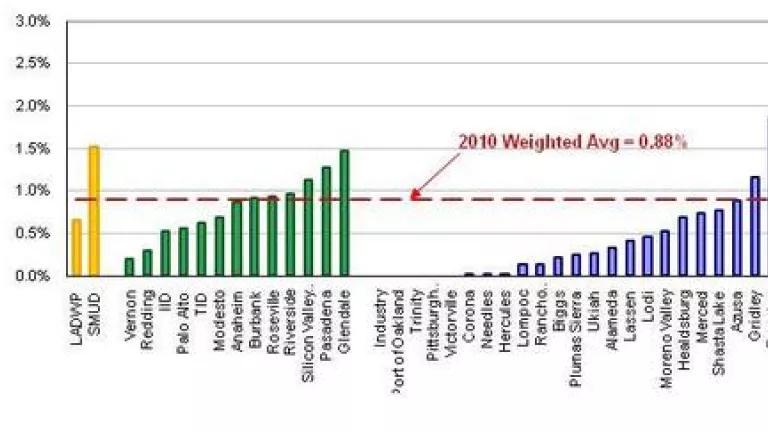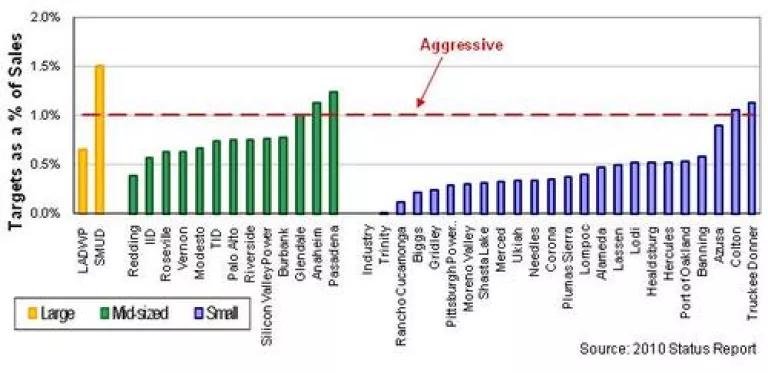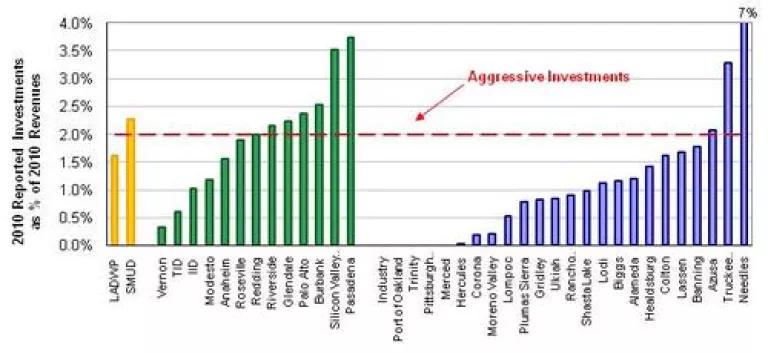
In a recent report issued by NRDC, we found that no matter which way you look at it, the Los Angeles Department of Water and Power (LADWP) is falling short on delivering energy efficiency. Energy efficiency, by law, is the state’s top priority energy resource, meaning utilities are required to invest in reducing demand before paying for more energy generation. In Los Angeles--which has the largest publicly owned utility in the nation, those investments are falling short.
On nearly every measurement, LADWP has missed the mark when they have the tools to surpass them (each of the following graphs are found in our report). In 2010, LADWP energy efficiency savings were well below 1%. Sacramento’s public utility, the second largest public utility in the state, achieved more than twice the savings.
2010 Savings as a Percent of Sales

In a worrying sign of worse things to come, last year all of the publicly owned utilities were required to assess how much energy demand they could meet by improving energy efficiency over the next ten years. LADWP failed to release any assessment, but in the resource plan they released, they projected average energy savings over the 10-year period that amounts to 36% less than their 2007 target (the targets are set every three years) and averages 0.65% of sales. These targets are well below national best practice, and fall short of what several more active publicly owned utilities in the state are planning.
2010-2020 Average Annual Energy Saving Targets as a Percent of Projected Retail Electricity Sales

Indeed, The POU aggregate targets are 12% lower than previous targets set in 2007. However, when LADWP is excluded, the POUs in aggregate adopted a 3% increase in targets relative to their 2007 targets! The graph below shows the percent change in average 2010 annual targets from the 2007 targets. On average, the Mid-sized and Small utilities increased their targets.
Percent Change in 2010 Targets Relative to Targets Adopted in 2007

Part of the problem is that LADWP is under investing in energy efficiency. Compared to many of the better-performing public utilities, LADWP is investing a smaller percentage of revenue to achieve energy savings. Recent indications from LADWP management indicate that they intend to reduce those investments even further in years to come.
2010 Investments as a Percent of Revenue

LADWP should be a leader in energy efficiency--it’s the fastest, cheapest and cleanest energy resource available. More energy efficiency would help LADWP, and its customers, across the board: lower demand means fewer reliability concerns, less pollution, and fewer power plant upgrades. Reducing total demand makes compliance with the state’s 33% renewable mandate cheaper.
There are plenty of good examples around the state of utilities that are achieving far better results.
Here are three ways LA could save more energy:
1) LADWP must secure a significant multi-year energy efficiency budget. A real budget commitment would ensure sufficient investments and provide certainty that LADWP is serious about maintaining momentum on energy savings.
2) LADWP needs to open up its energy efficiency program planning. There are plenty of great experts (LADWP General Manager Ron Nichols used to work at a leading firm). LADWP should reach out and open its doors to new ideas.
3) LADWP needs a transparent and consistent approach to evaluation and measurement of efficiency program results. The sad truth is that the savings reported in the graphs above are based on LADWP estimates, without any transparent or independent evaluation. Transparent evaluation can vastly improve energy efficiency programs--improving savings opportunities and reducing costs.
LADWP is going to have to step it up if California is to remain the nation’s leader in energy efficiency.